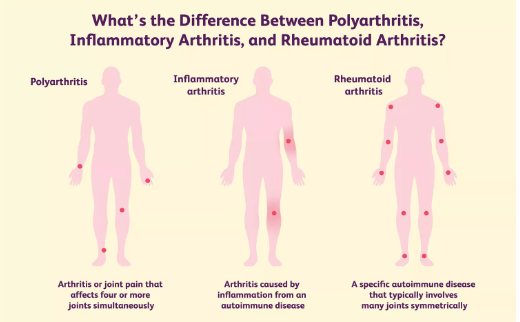How They Are Related—and How They Differ
By Carol Eustice
Medically reviewed by David Ozeri, MD
The terms "inflammatory polyarthropathy,' "inflammatory arthritis," and rheumatoid arthritis" (RA) are often used interchangeably. While they are related, they don't mean the same thing. RA is a disease, while the other two are ways of describing a particular case of arthritis (how many joints are affected and the genesis of the disease).
The word "polyarthropathy" literally means "disease in many joints." It's used in the same context as "polyarthritis" (inflammation in many joints).

Inflammatory Polyarthropathy
Inflammatory polyarthropathy/polyarthritis is defined as arthritis that affects four or more joints.1 It's not a type of arthritis and can be applied to many types of arthritis in which the disease process is driven by inflammation.
Conditions that can cause polyarthropathy include:1
Rheumatoid arthritis
Psoriatic arthritis
Ankylosing spondylitis
Reactive arthritis
Spondyloarthropathies
Lupus
Systemic vasculitis
Treatments and the prognosis for polyarthropathy depend on the condition causing it.
From Acute Illness
Polyarthritis isn't only tied to chronic illnesses. It also can be a transient symptom of a passing illness such as rheumatic fever.2
Inflammatory Arthritis
The term inflammatory arthritis typically refers to arthritis due to autoimmune disease in multiple joints throughout the body. In autoimmune disease, your immune system misfires and attacks the body's own tissues. The damage it causes leads to inflammation.3
An exception is gout, which is classified as inflammatory but isn't autoimmune.
Arthritis caused by inflammation is often associated with joint pain and stiffness, especially after periods of rest or inactivity, such as in morning stiffness. Swelling, redness, and warmth may surround the affected joints.3
Types of inflammatory arthritis include:4
Rheumatoid arthritis
Psoriatic arthritis
Ankylosing spondylitis
Gout and pseudogout
Lupus
Lyme disease
As with inflammatory polyarthropathy, treatments and outcomes for inflammatory arthritis depend on the specific diagnosis.
Inflammatory arthritis may also be associated with systemic effects such as fatigue, fever, rash, and organ involvement.
Rheumatoid Arthritis
Rheumatoid arthritis is a specific disease that is, by definition, a type of inflammatory polyarthritis. It's an autoimmune disease that typically involves many joints symmetrically (the same joint on both sides of the body) and may be associated with systemic effects.
In RA, the immune system attacks the lining of the joint (called the synovium) and causes inflammation, which leads to joint damage. Without treatment, this disease can lead to serious disability.
Early and aggressive treatment of rheumatoid arthritis can help prevent joint damage from inflammation.5 Disease-modifying anti-rheumatic drugs (DMARDs) and biologic drugs, often used in combination, are common parts of the treatment regimen.
TNF blockers, which are a type of biologic drug, effectively reduce chronic inflammation, decrease mortality, and reduce the risk of cardiovascular events in people with this disease.
Polyarthropathy vs. Inflammatory Arthritis vs. Rheumatoid Arthritis: Key Differences
While there's some overlap in the definitions, these terms mean different things.
Inflammatory polyarthropathy/polyarthritis:
Affects four or more joints
Is a description of arthritis, not a type
Is tied to chronic and acute illnesses
Doesn't imply systemic symptoms (although many inflammatory polyarthropathies involve them)
Treatment depends on underlying illness
Inflammatory arthritis:
Affects multiple joints
Is a description of arthritis, not a type
Is tied to autoimmune and inflammatory disease
May involve systemic symptoms
Treatment depends on underlying illness
Rheumatoid arthritis:
A type of autoimmune/inflammatory arthritis
Affects the lining of many joints
Can be described as inflammatory polyarthropathy or inflammatory arthritis
May involve systemic symptoms
Treatments include DMARDs and biologics
If your healthcare provider is using one of the above terms and you don't understand what it means in relation to your symptoms or diagnosis, be sure to ask. The better you understand what's going on in your body, the better armed you are to manage it, alleviate symptoms, and improve your quality of life.
Sources
Alpay-Kanıtez N, Çelik S, Bes C. Polyarthritis and its differential diagnosis. Eur J Rheumatol. 2018;6(4):167-173. doi:10.5152/eurjrheum.2019.19145
Shankar B, Bhutia E, Kumar D. Atypical arthritis revisited: Acute rheumatic fever. Ann Pediatr Cardiol. 2016;9(2):164-166. doi:10.4103/0974-2069.180670
Arthritis Foundation. Tracking disease activity in inflammatory arthritis.
Hospital for Special Surgery. Inflammatory arthritis.
Merck Manual Professional Version. Rheumatoid arthritis (RA).
Additional Reading
Raza K, Filer A. The therapeutic window of opportunity in rheumatoid arthritis: Does it ever close? Ann Rheum Dis. 2015;74(5):793-794. doi:10.1136/annrheumdis-2014-206993
By Carol Eustice
Carol Eustice is a writer covering arthritis and chronic illness, who herself has been diagnosed with both rheumatoid arthritis and osteoarthritis.





Post comments